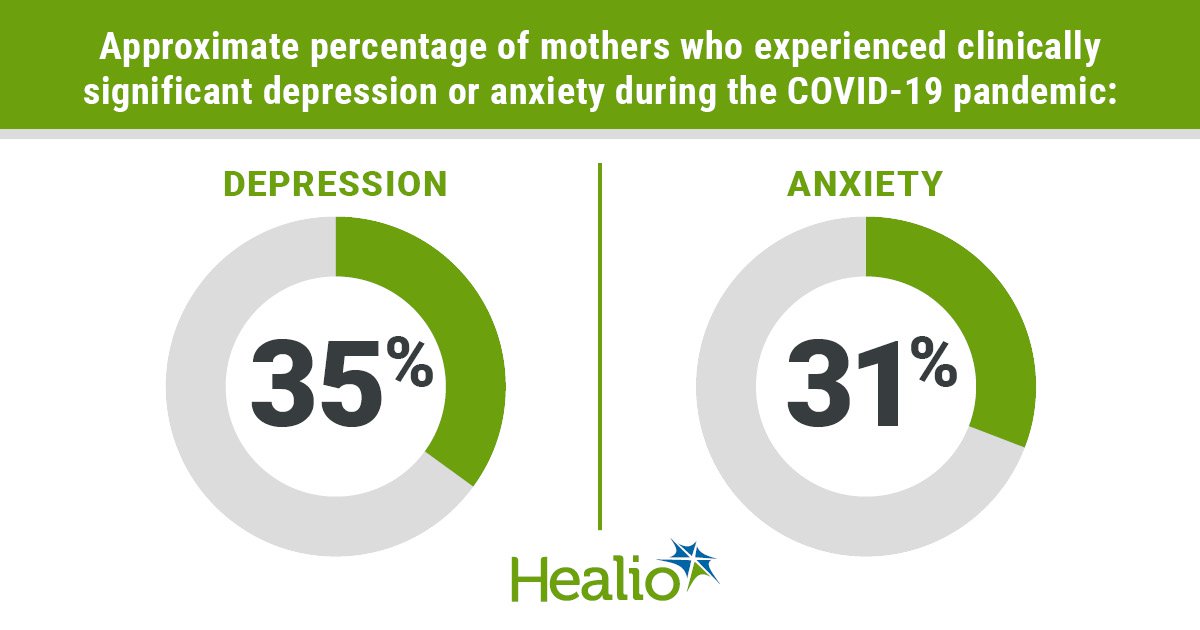March 30, 2021
2 min read
Rates of maternal depression and anxiety have increased during the COVID-19 pandemic compared with prior estimates, according to results of a longitudinal analysis conducted in Canada and published in The Lancet Psychiatry.
“One group that has been particularly affected by the social and financial ramifications of the COVID-19 pandemic are parents, especially mothers,” Nicole Racine, PhD, of the department of psychology at Alberta Children’s Hospital Research Institute, and colleagues wrote. “In addition to working to maintain a livelihood, some parents have adopted caregiving or homeschooling roles. Cross-sectional studies of maternal mental health problems during the COVID-19 pandemic have found approximately 30% of mothers reporting clinically significant symptoms of depression or anxiety.”

Reference: Racine N, et al. Lancet Psychiatry. 2021;doi:10.1016/S2215-0366(21)00074-2.
A lack of data has limited all studies of depression and anxiety symptoms among mothers from the pre-pandemic period, which has not allowed within-person change over time to be assessed, according to the researchers. In the current study, they analyzed data of 1,301 women who completed a COVID-19 impact survey as part of a pregnancy cohort in Canada between May 20, 2020, and July 15, 2020. They compared symptoms of maternal depression and anxiety during the pandemic with three prior estimates obtained at 3-, 5- and 8-year timepoints between April 2012 and October 2019. They used the 10-item Center for Epidemiological Studies Depression scale to assess depression symptoms and the short form of the Spielberger State-Trait Anxiety Inventory to assess anxiety symptoms. Further, they assessed temporal trends via repeated cross-sectional analyses and fitted fixed-effects regressions models to evaluate within-person change over time.
Results showed more women had clinically significant depression (35.21%) and anxiety symptoms (31.39%) at the COVID-19 impact survey timepoint compared with all previous timepoints of data collection. Racine and colleagues noted a mean depression score of 8.31 and mean anxiety score of 11.9 at the pandemic timepoint, and these were higher compared with data collected at the 3-year timepoint, 5-year timepoint and 8-year timepoint. The researchers adjusted for time trends and reported depression scores were a mean of 2.3 points higher and anxiety scores 1.04 points higher at the pandemic timepoint for within-person comparisons. They also reported larger increases in depression and anxiety symptoms among women with income disruptions, difficulty managing homeschooling and work responsibilities and those with difficulty getting childcare. White mothers’ anxiety scores exhibited greater increases vs. non-white mothers and health care workers exhibited smaller increases in depressive symptoms vs. non-health care workers.
“An important topic for future research is to identify the mechanisms, specifically how and for whom, by which mental health problems increased during the COVID-19 pandemic, and to determine the persistence of increased mental distress,” Racine and colleagues wrote. “Some research has suggested a narrowing of gender-based parenting roles during the COVID-19 pandemic, highlighting the need to reexamine the mental distress of mothers as the COVID-19 pandemic progresses. Future work should also examine social support as a protective factor, and paternal mental health during the COVID-19 pandemic separately, and in comparison with maternal mental health.”

